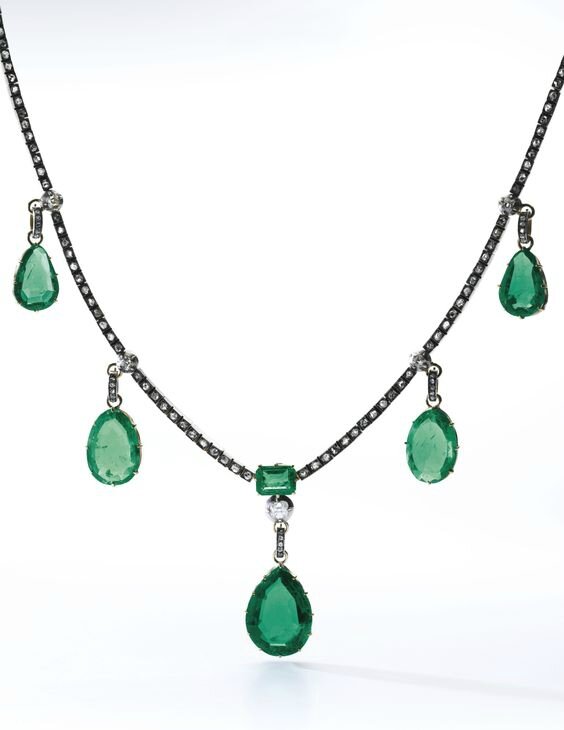Collection of the Duchesse de Berry. Emerald and diamond necklace and a pair of earrings, first half of the 19th century
Lot 402. Collection of Marie-Caroline of Bourbon-Two Sicilies (1798–1870), Duchesse de Berry. Colombian emerald and diamond necklace and a pair of earrings, first half of the 19th century. Estimate 675,000 — 960,000 CHF (616,893 - 877,359 EUR). Photo Sotheby's
The necklace set with rose diamonds, highlighted with cushion-shaped stones supporting detachable pendants set with rose diamonds and pear-shaped emeralds, the central stone weighing 14.03 carats, the clasp and the center further accented with step-cut emeralds, length approximately 385mm; each earring surmount set with a step-cut emerald surrounded with cushion-shaped diamonds, supporting a detachable pendant set with a cushion-shaped emerald, similarly shaped and rose diamonds, post and hinged back fittings, fitted case.
Accompanied by SSEF report no. 84510, stating that the emeralds are of Colombian origin, three with a minor amount of oil in fissures, the others with a moderate amount of oil in fissures.
Provenance: From the Collection of Marie-Caroline of Bourbon-Two Sicilies (1798–1870), Duchess of Berry (1816), then Duchess della Grazia (1831), thence by descent.
Marie-Caroline of Bourbon-Two Sicilies (1798–1870), Duchesse de Berry.
Notes: The Duchess of Berry is one of the most famous and fascinating aristocrat figures of the 19th century, who led an adventurous and courageous life in the turmoil of French politics.
Born Marie-Caroline of Bourbon-Two Sicilies (5 November 1798 – 17 April 1870), the eldest child of Prince Ferdinand, the future King Francis I of the Two Sicilies, and Archduchess Maria Clementina of Austria, she married on 24 April 1816 in Naples, Charles Ferdinand, Duke of Berry, King Louis XVIII of France’s nephew, son of the future King Charles X, great grandson of King Louis XV. The Duke and Duchess of Berry lived at the Elysée Palace in Paris and had four children, only two of them survived: Louise Marie Thérèse, future Duchess of Parma, and Henri.
The Duke was assassinated in 1820 and the Duchess was then pregnant with their fourth child, Henri, Count of Chambord (1820-1883), who was dubbed the ‘miracle child’, as his birth continued the direct Bourbon line of King Louis XIV of France. He became the heir to the Throne of France and his mother was an important figure in the politics of the Bourbon Restoration.
In 1824, Louis XVIII died and was succeeded by his brother, Charles X, the widow Duchess’s father-in-law.
In the July Revolution of 1830, Charles X was overthrown. Both Charles X and his elder son abdicated. Their cousin, Louis-Philippe d’Orléans, allowed the National Assembly to declare him king and he became ‘King of the French’. The Duchess of Berry did not accept her son’s exclusion from the Throne of France and she declared her son to be the legitimate King of France and herself to be regent. In 1831, she returned to her family in Naples. There, with the help of the Viscount de Saint-Priest, she intrigued for a legitimist rebellion to restore her son Henri to the throne.
On 14 December 1831, she secretly married Ettore Carlo Lucchesi-Palli, Count Lucchesi-Palli, Duke della Grazia (1806-1864), son of Antonio Lucchesi Palli, Prince di Campofranco, Duke della Grazia, and Maria Francesca Pignatelli. In June 1832, in Vendée and Brittany, she succeeded in instigating a brief but abortive insurrection. She was betrayed to the government in November 1832 and imprisoned in the Château of Blaye. During her incarceration, she gave birth to a daughter and her marriage was revealed. She thus lost the sympathies of the Legitimists and because of her remarriage to an Italian aristocrat, she was ineligible to serve as a regent of France. She was no longer an object of fear to the French government which released her in June 1833.
In 1844, the Duchess purchased the beautiful palazzo Ca’ Vendramin Calergi, on the Grand Canal in Venice.
As a patron of the arts, she was an enthusiastic collector, with passions for music, botany, garden design and literature – her library in the Château de Rosny was legendary. She was also known to patronise Sèvres porcelain, and commissioned numerous notable works throughout her life.
Sotheby's. Magnificent Jewels and Noble Jewels, Genève, 17 mai 2016, 10:00 AM

/https%3A%2F%2Fprofilepics.canalblog.com%2Fprofilepics%2F1%2F0%2F100183.jpg)
/https%3A%2F%2Fstorage.canalblog.com%2F03%2F02%2F119589%2F96711876_o.jpg)
/https%3A%2F%2Fstorage.canalblog.com%2F11%2F31%2F119589%2F94773502_o.jpg)
/https%3A%2F%2Fstorage.canalblog.com%2F20%2F83%2F119589%2F94772815_o.jpg)
/https%3A%2F%2Fstorage.canalblog.com%2F26%2F72%2F119589%2F75604929_o.jpg)
/https%3A%2F%2Fstorage.canalblog.com%2F59%2F60%2F119589%2F26458628_o.jpg)






/http%3A%2F%2Fstorage.canalblog.com%2F95%2F39%2F119589%2F111914967_o.jpg)
/http%3A%2F%2Fstorage.canalblog.com%2F95%2F75%2F119589%2F110537016_o.jpg)
/http%3A%2F%2Fstorage.canalblog.com%2F42%2F08%2F119589%2F110224178_o.jpg)
/http%3A%2F%2Fstorage.canalblog.com%2F97%2F24%2F119589%2F105375107_o.jpg)